Friday December 6, 2024
Williams Center for the Arts
8:00 pm
Program
Keepers of the House (2022)
Conni Ellisor (b. 1953)
I. Atmospheric
II. Andante, but with liberty
I am intrigued by the relatively new data that all trees are interconnected; that indeed they communicate, send energy to each other, and care for each other. The evidence is overwhelming that all of our forests are alive and communicating, that the “magical trees’ we dreamed about as children are real. And I wonder what that means for us. I find it unlikely that we are the exception, but more probably we’ve just lost the innate intuition that we are also part of the vast interwoven web of life.
Notes by Conni Ellisor
Symphonic Dances from West Side Story (1957)
Leonard Bernstein (1918 – 1990)
transcribed by Paul Lavender
Prologue
“Somewhere”
Scherzo
Mambo
Cha-Cha
Meeting Scene
“Cool” / Fugue
Rumble
Finale
In 1961, some four years after the wildly successful stage premiere, Leonard Bernstein prepared an orchestral suite from the score to West Side Story. Rather than make a medley of only the most well-known tunes, Bernstein chose to build this suite from incidental music occurring under dialog, between scenes, and during dance sequences. Much of this music is derived from the well-known songs, but not simple instrumental renderings of the vocal lines. The resulting 25-minute suite is in nine sections, which are presented more or less in the order they would appear in a production: just this excerpted music provides the listener with a great deal of detail about plot and character. The sections are listed above.
One of Bernstein’s most performed orchestral works, Symphonic Dances was transcribed twice for winds. The transcription being performed this evening was prepared by Paul Lavender for the United States Marine Band, “The President’s Own” in 2006.
This piece is perhaps Bernstein at his most vibrant: it is filled with infectious and complex rhythms (note the dual meters in the Prologue–a text painting device that represents in musical terms the conflict between the Sharks and the Jets), poignant melodies, and profound and widely diverse emotional states (one can literally feel Ice holding Action back in the Fugue). Many of these melodies are based on the augmented fourth interval–the tritone, diablus in musica: this appears most prominently in Maria, but one can hear the motive in the Prologue, Mambo, Cool, the Fugue, and in the Finale, where the augmented fourth is used harmonically as metaphor for the “two worlds” which separate the two rival gangs.
Pause to reset the stage
Rhapsody in Blue (1924)
George Gershwin (1898 – 1932)
Holly Roadfeldt, piano
On January 4, 1924, Ira Gershwin brought a brief item in the New York Tribune to the attention of his younger brother George. Its heading read, “Whiteman Judges Named. Committee Will Decide ‘What Is American Music.’ “ According to the advertisement (purely a media ploy), Paul Whiteman had assembled an impressive group of musicians including Sergei Rachmaninoff and Jascha Heifetz to witness a concert of new American music. This concert was to be presented on the afternoon of February 12, just five weeks away. Included would be “a jazz concerto” on which George Gershwin was currently “at work.” Busy with his show Sweet Little Devil, Gershwin had not begun to compose such a concerto, though he and Whiteman had casually talked about his writing a special piece for the band. Gershwin began work on Rhapsody in Blue on Monday, January 7. Though a gifted melodist, he was ill-equipped to score the accompaniment. To assist him, Whiteman offered the services of his chief arranger, Ferde Grofé, who completed the score on February 4. The first of five rehearsals was held immediately, during which several modifications were made both to Gershwin’s music and Grofé’s arrangement. Most notable among these is the change in the opening clarinet solo. Gershwin had originally written a seventeen-note slur; however, Ross Gorman (Whiteman’s lead reed player) improvised the signature clarinet “wail.” According to contemporary reviews, the concert was rather dull, but Rhapsody in Blue was received enthusiastically by the audience, which included Jascha Heifetz, Victor Herbert, Fritz Kreisler, Sergei Rachmaninoff, John Philip Sousa, Leopold Stokowski and Igor Stravinsky. There were subsequent performances on March 7 and April 21, and a recording was made for Victor Records on June 10. A second recording was scheduled in 1927 during which Gershwin and Whiteman had strong disagreements. During those three years, Whiteman had made changes in the work with which Gershwin was dissatisfied. Their argument at the session resulted in Whiteman walking off the podium. The recording did take place with Gershwin performing the solo and the Whiteman Band playing the accompaniment, but Nathaniel Shilkret, Victor’s director of light music, served as conductor.
In ensuing years, there were a number of versions of Rhapsody in Blue produced to satisfy public demand for as many accessible renditions as possible. As the work’s popularity increased, the desire for a published large ensemble version led to Grofé’s 1926 setting for theater orchestra. This was followed subsequently by an expansion of the theater orchestra score for full symphony orchestra and a version for concert band (1938) both by Grofé as well.
Not until 1987 was Grofé’s 1924 arrangement for the Whiteman Band published (in facsimile). Since its availability, this first scoring has been performed regularly. However, in the sixty-three years between its premiere and publication, this version was all but abandoned. Whiteman himself did not adhere to this arrangement. As early as 1926, he began distorting the piece, which had become his signature tune. He kept adding instrumental parts to the first version as the instrumentation of his orchestra changed. More than ninety parts exist for the various instrumental combinations Whiteman had at any given time. While the first score is novel, it cannot be considered the definitive version of the work, any more than Gershwin’s two-piano manuscript. This manuscript was altered, presumably with the approval of the composer, by Grofé both melodically and harmonically. In fact, Grofé’s 1924 score was never performed as written, even at the premiere. Gershwin most assuredly improvised sections of the piano cadenza, and the written ensemble accompaniment evolved through the five days of rehearsals. Grofé was a gifted arranger (later teaching orchestration at Julliard) who commonly reduced existing orchestral scores for Whiteman’s unique instrumentation. (In 1927 he adapted Gershwin’s own scoring of Concerto in F for a Whiteman Band recording.)
As noted above, Grofé scored Rhapsody in Blue for concert band in 1928; however, this setting was flawed and somewhat unusable without considerable alteration. The primary problem lay in the absence of the solo piano! Grofé distributed the material contained in the solo piano part among the various voices of the ensemble. Eventually, an erratum was created and made available with the score indicating cuts and deletions in the band version to adapt for the addition of the original solo piano part. Also, unlike the scoring of the symphony orchestra version in which chord tones were characteristically assigned to specific players or sections, these chord tones were voiced within individual sections, and thus no distinct timbre was afforded each.
The shortcomings of this extant concert band version have led to the creation of the current modern edition, which may be performed by either concert band or wind ensemble (most effectively by the latter). The present edition preserves the characteristic timbres and transparent qualities of the orchestral setting while texturally capturing–despite the absence of strings–its innate vertical densities. Gershwin’s personal copy of Grofé’s symphony orchestra score (housed in the Library of Congress) has been used as a primary research source. Select string substitutions found in Grofé’s band setting have also been incorporated along with scoring options from the manuscripts of his theater orchestra and Whiteman Band versions (both also in the Library of Congress).
Notes by Thomas Verrier
This version, prepared as Verrier’s doctoral dissertation in Conducting at the University of Colorado, was premiered at the World Association of Symphonic Bands and Ensembles conference in Hamamatsu, Japan in 1995 by the University of Colorado Wind Symphony, Allan McMurray, conductor. Holly Roadfeldt-O’Riordan was the soloist.
Tonight’s performance celebrates the 100th anniversary of this wonderful work’s composition. It is particularly special to have a soloist who will be a part of the history of one of the most well-known and loved pieces of the last century.
Our Soloist
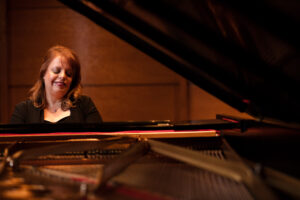 Few musicians balance the new opposite the old quite like American pianist Holly Roadfeldt. Recently deemed a “perfect pairing of technical prowess and innate sensitivity” (American Record Guide), Roadfeldt has established herself as one of contemporary music’s most prolific ambassadors—to date, she has made over 150 world premieres by more than four dozen composers. Recognized by audiences and critics for both her technical facility and distinctive interpretation of music from all eras, Roadfeldt has appeared on stages and venues across Canada, Europe, Asia, and over 30 U.S. states.
Few musicians balance the new opposite the old quite like American pianist Holly Roadfeldt. Recently deemed a “perfect pairing of technical prowess and innate sensitivity” (American Record Guide), Roadfeldt has established herself as one of contemporary music’s most prolific ambassadors—to date, she has made over 150 world premieres by more than four dozen composers. Recognized by audiences and critics for both her technical facility and distinctive interpretation of music from all eras, Roadfeldt has appeared on stages and venues across Canada, Europe, Asia, and over 30 U.S. states.
Roadfeldt tirelessly searches for like-minded composers who share her obsession with creating opportunities for listeners to relate to the music they hear. Best demonstrating this ethos is her three-year artistic flagship, “The Preludes Project,” which saw Holly premiere 65 new preludes by 16 composers. In touring the concept across 17 states, her lecture-recitals connected the present and the past, pairing the newly composed preludes with curated works within the standard repertoire. The concept drew rave reviews and attention across the industry, leading to Holly’s debut album, a collaboration with multi-GRAMMY® award winning producer Andreas Meyer. The Preludes Project CD (2016) released on PARMA Recordings, pairing Chopin’s Op. 28 Preludes with composer Kirk O’Riordan’s Twenty-Six Preludes for Solo Piano (2014). The album complements her numerous PARMA album collaborations with composers, including Mara Gibson’s Sky-Born (2017), and two other albums with O’Riordan: Strange Flowers (2013) and the recent release of Autumn Winds (2020), her second collaboration with Andreas Meyer.
Music critics across the United States, Canada, Italy, U.K., and Spain have taken notice, including American Record Guide, whose Autumn Winds review simply remarked that “Holly Roadfeldt is on fire.” Gramophone’s Donald Rosenberg praised her as “a vivid pianist” with “beautiful playing”, while for The Preludes Project CD, she received accolades from World Music Report for an “utterly convincing, breathtaking sense of elation” with “a varied touch that perfectly matches the mood of each piece.” Sonograma deemed the album worthy of “all of our highest praise,” joining other colorful superlatives like “jaw-dropping” (Mainly Piano) and “exquisite” (Cinemusical).
Known for premiering an eclectic array of exciting music, much of Roadfeldt’s recent pedagogical and artistic philosophy can be credited to Lisa, a 13-year old student who wondered why she “was only studying music written by men.” Driven to make that lesson the last time she heard that question, Holly has since prioritized including composers across the gender spectrum in her pedagogy. As a performer, composers she has commissioned span a number of the field’s most innovative voices, including Rasa Daukus, Mara Gibson, Michelle McQuade Dewhirst, Kala Pierson, Jessica Rudman, Julia Seeholzer, Stephanie Ann Boyd, and many others. With Lisa in mind, Roadfeldt hopes to encourage young female students to walk fearlessly down the road of self-expression and creativity.
Now a veteran of collaborating during the composition process, Holly pays her experience forward in masterclasses across the United States, teaching effective piano writing to university level composers. Her recurring lecture series “Classical Café” and “Classical Conversations” intersects Roadfeldt’s equal comfort with both performing and relating music to audiences. Taking place since 2017, each event explores themes like darkness, virtuosity, and even Bob Dylan, showing their direct influence on iconic repertoire throughout history using live musical examples.
Holly has taken the stage in myriad contexts and remains in high demand as a performer. Among her fondest memories are her performances of Chopin’s complete catalog of Preludes with revered Montréal-based dance troupe Compagnie Marie Chouinard. As a chamber musician, Holly has performed with members of the Metropolitan Opera Orchestra, the New York Philharmonic, the Chicago Symphony Orchestra, the Montreal Symphony, the Orchestre Philharmonique de Strasbourg, the Frankfurt Opera, the Finnish Radio Symphony Orchestra, and the Brussels Philharmonic as well as with concert artists Alexa Still, Bonita Boyd, and Marcia Baldwin.
Holly’s first professional performance came at 13 years old, performing with the Toledo Symphony Orchestra. Her fire in pursuing contemporary music ignited at the Eastman School of Music, where she was first able to collaborate with composers—Roadfeldt would go on to win First Prize in the Frinna Awerbuch International Piano Competition in its Contemporary Music category.
Holly is currently the Director of Keyboard Studies at Lafayette College. Previously, she taught at the University of Delaware, Susquehanna University, Muhlenberg College, Gettysburg College, the University of Colorado-Boulder, Indiana University, and was Artist Faculty with Distinction at The Music School of Delaware.
The Lafayette College Concert Band
Assistant Conductor
Samantha Semsel
LCCB President
Ellie Batchelar
—–
Piccolo
Jamie Lin
Flute
Brian Morris (Principal)
Olivia Wund
Emily Kozero
Samantha Semsel (Associate Principal)
Emma Martin
Iris Peluso
Lauren Kaye
Oboe
Nicole Bagdasarian
Olivia Bamford
Clarinet
Emily Rice (Principal)
Aram Ramsay
Priscilla Wu
David Broczkowski
Lily Hoogius
Ashley Kushner-Kmetz
Sungbum Lee (Military Service, 2024-26)
Will Cassidy
Christopher Ruebeck
Jennifer Blair
Bass Clarinet
Benjamin Alter
Bassoon
Sean Catarroja
Peter Rice
Saxophone
Julia Sealing (alto) (Principal)
Samuel Owens (alto)
Cassidy Baisley (alto)
Alex Kmetz (alto)
Chloe Williams (tenor)
Katie Rice (tenor)
Andrew Manni (baritone)
Horn
Madeline Paguia
Sophie Cron
Anastasia Krial-Victor
Nicholas Pignolo
Trumpet
William Blair
Corey Stein
Gavin Davis
Drew Borek
Tyler Grogg
Laura Watts
Trombone
Pedro dos Santos (Low Brass Principal)
Jackson Eshbaugh
Benjamin Zwicker
Bass Trombone
Christopher Taverner
Euphonium
Olin Rubinow
Tuba
Ryan Pignotti
Jack Kerekes
Kyle Gelatka
Piano
Daniel Ruggiero
Percussion
Will Hoelzel
Casey Alexander
Joe Freeston
Noam Raich
Jeff Watts
Henry Schrader
Graduating Seniors
Lafayette Faculty/Staff
LCCB Alumni
Guest Performers
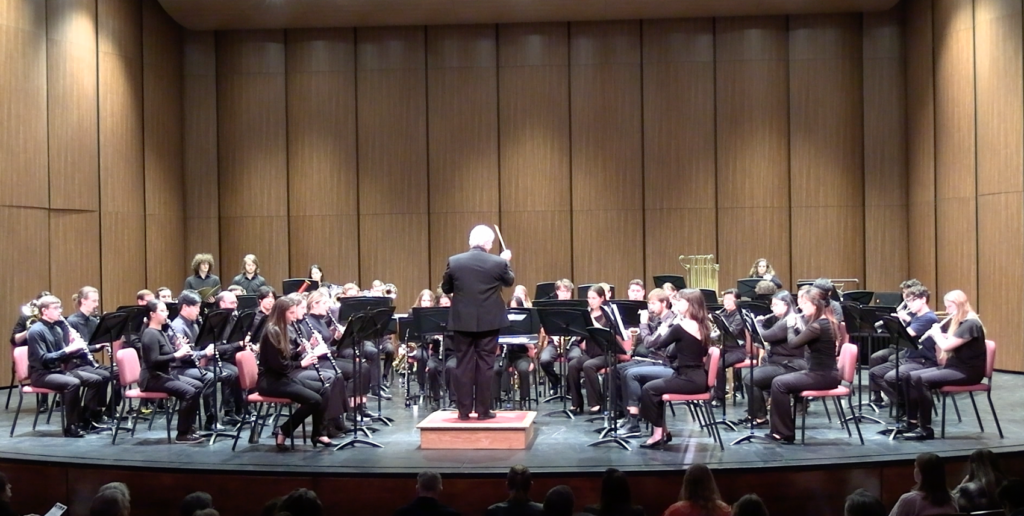 The Lafayette College Concert Band is comprised of approximately 50 students, faculty and alumni from a variety of majors who are united by a strong desire to perform the highest quality music at the height of their abilities. Participation in LCCB is open to students in any major as well as faculty and staff. The ensemble is conducted by Kirk O’Riordan, Associate Professor of Music.
The Lafayette College Concert Band is comprised of approximately 50 students, faculty and alumni from a variety of majors who are united by a strong desire to perform the highest quality music at the height of their abilities. Participation in LCCB is open to students in any major as well as faculty and staff. The ensemble is conducted by Kirk O’Riordan, Associate Professor of Music.
LCCB typically performs one concert each semester. The repertoire is selected from traditional concert band masterpieces, newer works by established and emerging composers, commissions, and orchestral transcriptions. Past concerts have included works such as Husa’s Music for Prague 1968, Bernstein’s Symphonic Dances from West Side Story, both Holst Suites, Grainger’s Lincolnshire Posy, and Mussorgsky’s Pictures at an Exhibition. LCCB has premiered works by composer/conductor Kirk O’Riordan and 2010 Pesky Artist in Residence William Pfaff as well as Ashley Kushner ’19 and Zach Jones ’13.
Students enroll for 1/4-credit. Open to all students, faculty and staff, LCCB employs a wind ensemble model for instrumentation. A seating audition is required before the first semester of participation. Due to the large numbers of flutists, clarinetists, saxophonists, and trumpeters, the number of available seats in these sections may be limited.
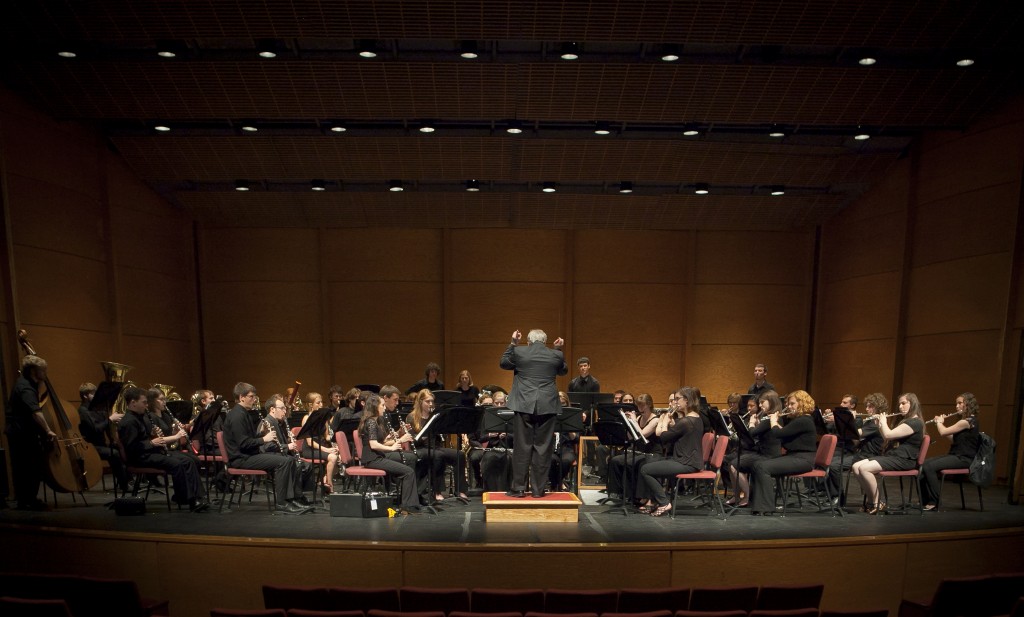 Several opportunities for leadership in the ensemble are available for highly motivated, experienced players. Principals in each section lead sectional rehearsals and help the less experienced players with technical issues. The Assistant Conductor is a highly advanced musician who has been studying conducting for at least one year prior to serving in the position. She/he conducts the ensemble on at least one piece in performance, having led all the rehearsals for that performance. Typically, that person also leads Pep Band and conducts the annual Marquis Players musical production. Finally, the LCCB President is nominated and elected by the student membership of the ensemble. This person works with the director and the Assistant Conductor on administrative tasks as a representative of the students.
Several opportunities for leadership in the ensemble are available for highly motivated, experienced players. Principals in each section lead sectional rehearsals and help the less experienced players with technical issues. The Assistant Conductor is a highly advanced musician who has been studying conducting for at least one year prior to serving in the position. She/he conducts the ensemble on at least one piece in performance, having led all the rehearsals for that performance. Typically, that person also leads Pep Band and conducts the annual Marquis Players musical production. Finally, the LCCB President is nominated and elected by the student membership of the ensemble. This person works with the director and the Assistant Conductor on administrative tasks as a representative of the students.
Blurred Days CD
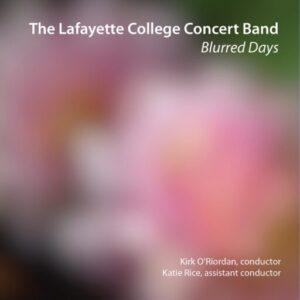 Like many bands and other performing ensembles across the country, we have had to adapt to the pandemic. For us, this has meant that we have not been able to work together, in person. This has always been a band that thrives on its sense of community, and not having that has been hard on all of us.
Like many bands and other performing ensembles across the country, we have had to adapt to the pandemic. For us, this has meant that we have not been able to work together, in person. This has always been a band that thrives on its sense of community, and not having that has been hard on all of us.
But rather than mourn what we have lost, we have searched for opportunities within our remote format that are unique. Working in isolation has allowed us to re-examine the possibilities of the Wind Ensemble as an entity—to re-imagine what is possible with this collection of sounds.
The five pieces on this CD were written especially for us, and especially for our situation. Each of the pieces was conceived to take advantage of techniques that would not be possible in a traditional concert—effects on a person-by-person level, or writing for flutes in their lowest register.
To make these performances, each student recorded his or her part on their phones or computers and uploaded them to either a shared drive or to the web-based recording service Band Lab. Katie Rice assembled the tracks and performed the first round of editing. I took the tracks she finished and combined them into the final product, completing the pre-production audio work.
Every student has a unique track in the recording, which allows us to use studio effects on a person-by-person level. With many of the pieces, the individual parts were created to be non-linear—we could create specific sonic effects and duplicate them in the recording software. Several of the pieces incorporate improvisation, narration, and other unconventional techniques.
Kirk O’Riordan, Conductor
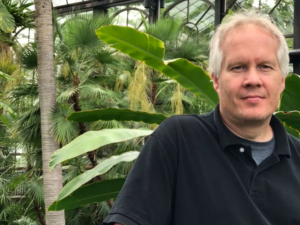 Kirk O’Riordan’s music has been referred to as “unapologetically beautiful” and is often praised for its uniquely “visual” qualities that depict a wide range of striking moods. His debut compact disk, Strange Flowers, was released by Ravello Records in November, 2013 and was praised by Audiophile Audition as “one of the most impressive and beautiful collections of chamber music I have heard in awhile….This is all just so lovely and invokes exactly the emotions that good music should be able to induce in all of us.” Gramophone Magazine praised O’Riordan as “a composer for whom imagery is a defining inspiration….[he] is a deeply sensitive composer who savours going gently into the night.” (April 2014).
Kirk O’Riordan’s music has been referred to as “unapologetically beautiful” and is often praised for its uniquely “visual” qualities that depict a wide range of striking moods. His debut compact disk, Strange Flowers, was released by Ravello Records in November, 2013 and was praised by Audiophile Audition as “one of the most impressive and beautiful collections of chamber music I have heard in awhile….This is all just so lovely and invokes exactly the emotions that good music should be able to induce in all of us.” Gramophone Magazine praised O’Riordan as “a composer for whom imagery is a defining inspiration….[he] is a deeply sensitive composer who savours going gently into the night.” (April 2014).
His recording of his Twenty-Six Preludes for Solo Piano—by pianist Holly Roadfeldt—has attracted similar praise: “are similarly atmospheric and proceed to unfold like a magical tapestry. Each of the 26 Preludes seemingly comprising of warp and weft forming a myriad of pixels of little pictures that ultimately combines to form a moveable feast for both eye and inner ear. O’Riordan’s miniatures are informed by languorous beauty and profundity, the lyrical variations of each often feature elaborate embellishments, as well as sudden dissonant figurations that seem to mimic the gravity-defying leaps of the gazelle…” (World Music Report, April 2017).
O’Riordan (b. 1968) is an active composer, conductor, saxophonist, and teacher. His music has been performed in Canada, China, Costa Rica, Cyprus, Finland, Italy, and Russia; and in thirty of the fifty United States. Performances of his works have been featured at the Ravenna Festival (Italy), the Indiana State University, University of North Carolina, Greensboro and Western Illinois New Music Festivals, the 2008 Eugene Rousseau Birthday Celebration, national and regional conferences of the Society of Composers, Inc. and the College Music Society; and in concert by such performers as the Eaken Piano Trio, Tresillo, The Moran Woodwind Quintet, Orchestra Bruno Maderna (Italy), the Arizona State University Chamber Winds and Symphony Orchestra, the Northwestern University Contemporary Music Ensemble, the Cleveland State University Orchestra, the University of Colorado Chamber Wind Ensemble, the University of Delaware University Singers, the Williamsport Chamber Chorus and Orchestra, the Susquehanna University Orchestra and Chamber Singers, The Lafayette College Concert Band, Contemporary Music Ensemble, and Percussion Ensemble, the SKIN Ensemble, Frederick Hemke, Timothy McAllister, Lawrence Stomberg, Marianne Gythfeldt, Kenneth Tse, Jeffrey Lyman, Emily Bullock, Steven Stusek, Andrew Rammon, Reuben Councill, John Perrine, and Holly Roadfeldt.
Kirk is the recipient of numerous awards as both a composer and a performer, including annual ASCAPlus awards, a Composer’s Assistance Program grant from the American Music Center, the 2001 Arizona State University Composition Competition, the 2000 Contemporary Music Society competition, and an ERM-Media Masterworks Prize. In addition, his Cadenza for Piano Trio was one of two works selected by audience members at the CMS Mid-Atlantic/Northeast Super-regional Conference for performance at the 2008 CMS National Conference.
Kirk’s music has been broadcast on WSMR, KBAQ, WQSU, and WVIA radio. Recordings of his works appear on the Crystal Records, Ravello, Centaur, ERM-Media and EnF labels, and feature performances by Kenneth Tse, Lawrence Stomberg, Marianne Gythfeldt, Holly Roadfeldt, Frederick L. Hemke, The Kiev Philharmonic, and Farrell Vernon. He has recently received commissions from AVIDduo, Saxton Rose, and Holly Roadfeldt. He recently completed his first opera: The Masque of Edgar Allan Poe, a one-act chamber opera based on Poe’s “Masque of the Red Death” on a libretto by Lafayette College colleague Lee Upton. The work was premiered by the University of Delaware Opera Theater in November, 2016 and subsequently at Lafayette College. Other projects have focused on music for dance: his River Lights for Orchestra (as recorded by the Kiev Philharmonic) was used by dancer/choreographer Ben Munisteri in his piece, Robot vs. Mermaid. O’Riordan has also collaborated with dancer/choreographers Carrie Rohman and Nandini Sikand. Recent projects include a concerto for Taiko Ensemble and Concert Band (for the Lafayette College Percussion Ensemble and Concert Band), incidental music for a Lafayette College Department of Theater production of Mary Zimmerman’s play Metamorphosis, and a new work for viola and piano for violist Michael Hall and pianist Holly Roadfeldt.
Dr. O’Riordan joined the faculty of Lafayette College in 2009, and now serves as Associate Professor of Music and Director of Bands, teaching courses in music theory, and composition. In addition, he teaches in the First-year Seminar program and conducts the Lafayette College Concert Band and Contemporary Music Ensemble. During his time at Lafayette, the Concert Band has been hailed for its ambitious and adventurous programming, having performed works such as Husa’s Music for Prague 1968, his own orchestration of Pictures at an Exhibition, and world premieres by O’Riordan, Ashley Kushner, Justin Kogasaka, Zach Jones, Pete Deshler, and William Pfaff. Previously, he served on the faculties of Bucknell University and Susquehanna University where he taught music theory, composition, music appreciation, and (English) writing. He has also served on the faculties of Lock Haven University, Colorado Christian University, Chandler-Gilbert Community College, and Paradise Valley Community College. He holds the Doctor of Musical Arts degree from Arizona State University (the first recipient of that degree from ASU); the Certificate of Performance in Saxophone from Northwestern University; and three Master of Music degrees (composition, saxophone performance, and conducting).
Kirk has studied composition with Rodney Rogers, Randall Shinn, James De Mars, Glenn Hackbarth, Jay Alan Yim, Burton Beerman, Marilyn Shrude, and Donald M. Wilson. He has studied saxophone with Frederick L. Hemke, John Sampen, Eugene Rousseau, and Iwan Roth. In his free time, Kirk is an avid fan of Obstacle Course Racing.